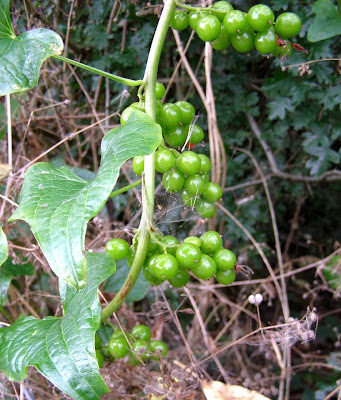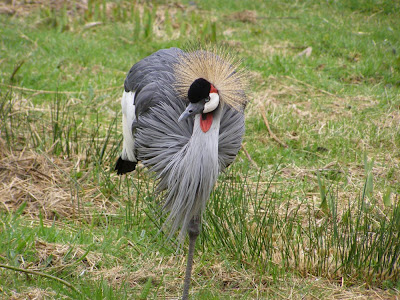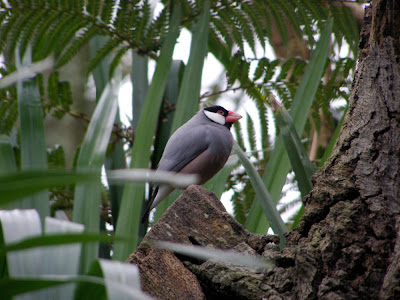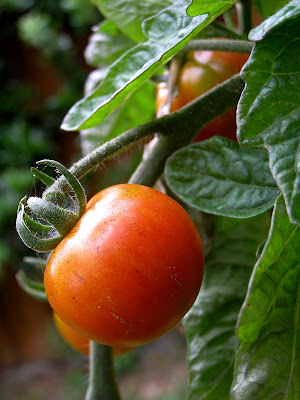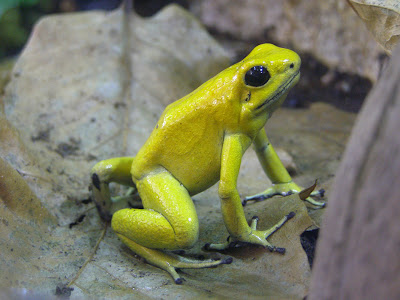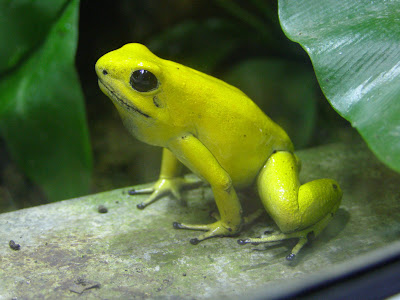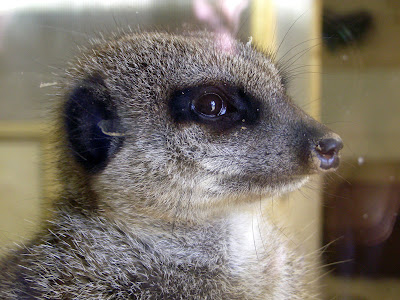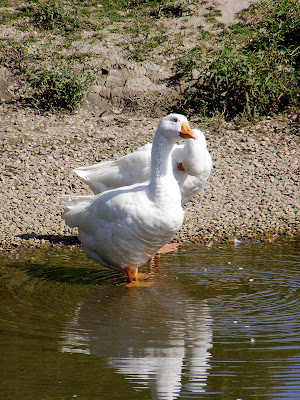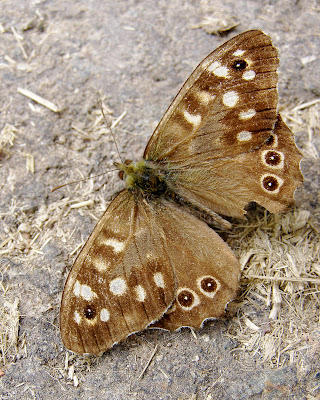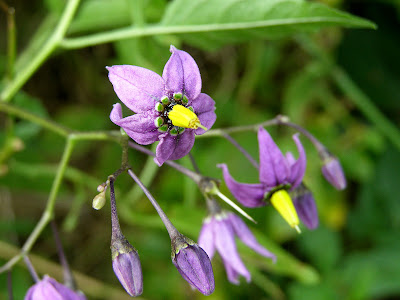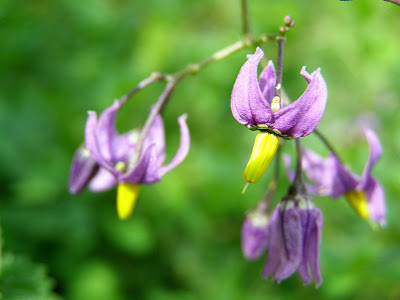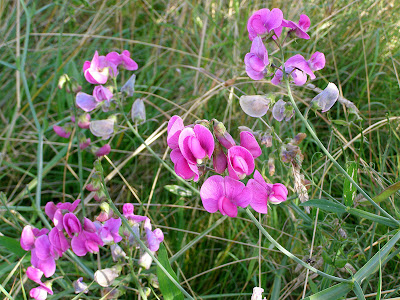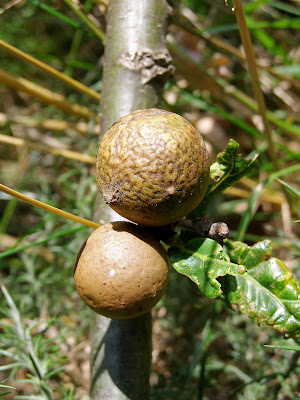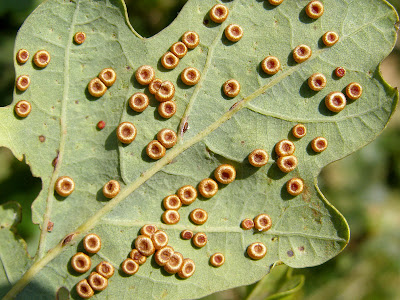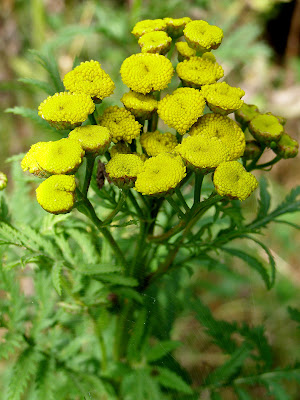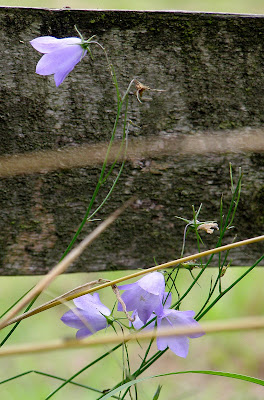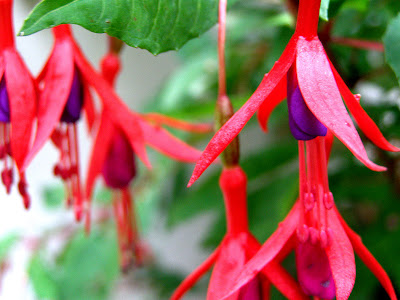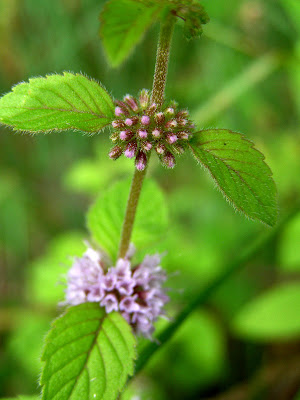With a couple of days away coming up, there will be fewer posts for a while. In the meantime however, a couple more pieces of music to enjoy.
Another from Sarah Brightman to start with. The traditional favourite, Scarborough Fair.
Secondly, Sarah again, this time teaming up with Jose Carreras to sing 'Amigos Para Siempre'. With some cute Polar Bears to look at too!
Lovely!
Welcome to my blog. Don't expect anything too high-tech or flashy, this is simply a 'diary' to share some of my photos, thoughts and observations - with a particular bias towards the natural world and the countryside around my home.
Sunday 30 August 2009
Friday 28 August 2009
Wet!
We set out for our walk this morning, ignoring the strong winds and cooler than normal temperatures. We got no further than a quater of a mile when the sight of heavy rain approaching from the direction of Shipley Hill curtailed our walk and forced a hasty retreat. Back home, the rain started and the wind lashed it against the windows - typical August weather!
Our mothers are due to return today from their short break in Scotland. Lets hope they have had some decent weather and managed to get out and about. We'll see!
To cheer things up a bit, here is some music. The wonderful 'Canto Della Terra' sung by Andrea Bocelli and Sarah Brightman - simply beautiful. Turn the sound up full and enjoy.
Thursday 27 August 2009
Fruits and Flowers
A nice walk of about 6 miles this morning, along the Nutbrook Trail toward Kirk Hallam. Nice to get a decent walk after the wind and rain of yesterday. The hedgerows are full of berries as the Summer ripens into Autumn. Among the more unusual berries beginning to ripen are those belonging to the Black Bryony (Tamus communis).
The shiny, heart-shaped leaves arranged along it's climbing stems are accompanied by bunches of fruits which look a little like bunches of grapes before they ripen to a bright red. Like the rest of the plant, they are poisonous and will cause great discomfort of the stomach if eaten.
One of the few flowers to be found still in bloom at the moment, is this small, pink and delicate specimen, Common Centaury (Centaurium erythraea).
According to Culpepper's Herbal, "This herb, boiled and drank, purges choleric and gross humours, and helps the sciatica; it opens obstructions of the liver, gall, and spleen, helps the jaundice, and eases the pains in the sides and hardness of the spleen, used outwardly, and is given with very good effect in agues. It helps those that have the dropsy, or the green-sickness, being much used by the Italians in powder for that purpose. It kills the worms in the belly, as is found by experience."
Another pink flower and one which I have mentioned before is the Himalayan Balsam (Impatiens glandulifera).
A highly invasive species, it produces large quantities of nectar making it very attractive to pollinating insects. It then produces many seeds which are distributed by means of the seed-pod exploding and flinging them asunder. Their invasive nature has resulted in gangs of 'Balsam Bashers' in some parts of the country, as a means of controlling them.
The shiny, heart-shaped leaves arranged along it's climbing stems are accompanied by bunches of fruits which look a little like bunches of grapes before they ripen to a bright red. Like the rest of the plant, they are poisonous and will cause great discomfort of the stomach if eaten.
One of the few flowers to be found still in bloom at the moment, is this small, pink and delicate specimen, Common Centaury (Centaurium erythraea).
According to Culpepper's Herbal, "This herb, boiled and drank, purges choleric and gross humours, and helps the sciatica; it opens obstructions of the liver, gall, and spleen, helps the jaundice, and eases the pains in the sides and hardness of the spleen, used outwardly, and is given with very good effect in agues. It helps those that have the dropsy, or the green-sickness, being much used by the Italians in powder for that purpose. It kills the worms in the belly, as is found by experience."
Another pink flower and one which I have mentioned before is the Himalayan Balsam (Impatiens glandulifera).
A highly invasive species, it produces large quantities of nectar making it very attractive to pollinating insects. It then produces many seeds which are distributed by means of the seed-pod exploding and flinging them asunder. Their invasive nature has resulted in gangs of 'Balsam Bashers' in some parts of the country, as a means of controlling them.
Wednesday 26 August 2009
Watch the Birdy
Some more pictures today from our visit to the Durrell Zoo on Jersey last year. This time some of the birds to be found there. To begin with, a tall and stately bird called a Sarus Crane (Grus antigone antigone).
The Sarus Crane is from India, South-East Asia and Australia and is classed as a 'vulnerable' species. Inhabiting wetlands and marshes, they stand a good 6' tall and as such are the world's tallest flying birds. Their numbers have declined drastically over the past hundred years or so. Some reports put their population at only 2.5% of their numbers in the 1850's.
The name 'Sarus' comes from the Hindi name for the crane which in turn comes from the ancient Sanskrit word 'sarasa', meaning Lake Bird. Sarus Cranes are omnivorous and will eat almost anything, from insects, crustaceans and fish, to aquatic plants, seeds and roots.
A second Crane now, the Grey Crowned Crane (Balearica regulorum).
These are not so endangered as the Sarus Crane and come from continental Africa, living in dryer areas of savannah, south of the Sahara. About half the height of the Sarus Crane, they eat much the same types of things. Despite it's being classed as 'of least concern', they are nonetheless, under threat from drainage of their wetland breeding grounds and overgrazing, as well as insecticide usage.
A much smaller bird to end with. A Java Sparrow (Padda oryzivora).
Again, described as 'vulnerable', their natural habitat in Java, Bali and parts of Indonesia is being eroded by agricultural use. As the Sparrows eat seeds, there is a conflict of interest between farmer and bird - as in all cases such as this, the bird comes off worse. It's scientific name 'Padda' is a reference to it's liking for rice - or Paddy - fields.
The Sarus Crane is from India, South-East Asia and Australia and is classed as a 'vulnerable' species. Inhabiting wetlands and marshes, they stand a good 6' tall and as such are the world's tallest flying birds. Their numbers have declined drastically over the past hundred years or so. Some reports put their population at only 2.5% of their numbers in the 1850's.
The name 'Sarus' comes from the Hindi name for the crane which in turn comes from the ancient Sanskrit word 'sarasa', meaning Lake Bird. Sarus Cranes are omnivorous and will eat almost anything, from insects, crustaceans and fish, to aquatic plants, seeds and roots.
A second Crane now, the Grey Crowned Crane (Balearica regulorum).
These are not so endangered as the Sarus Crane and come from continental Africa, living in dryer areas of savannah, south of the Sahara. About half the height of the Sarus Crane, they eat much the same types of things. Despite it's being classed as 'of least concern', they are nonetheless, under threat from drainage of their wetland breeding grounds and overgrazing, as well as insecticide usage.
A much smaller bird to end with. A Java Sparrow (Padda oryzivora).
Again, described as 'vulnerable', their natural habitat in Java, Bali and parts of Indonesia is being eroded by agricultural use. As the Sparrows eat seeds, there is a conflict of interest between farmer and bird - as in all cases such as this, the bird comes off worse. It's scientific name 'Padda' is a reference to it's liking for rice - or Paddy - fields.
Tuesday 25 August 2009
Nature's Bounty
Having a tin of condensed milk in the kitchen cupboard, it is imperative to have blackberries to go with it. The combination is a match made in Heaven. So, with this in mind, Malcolm and I took a small bag with us this morning as we walked around Shipley Park and collected some wild Blackberries. The bushes are loaded this year and there are millions of berries left for the birds and wasps, despite the dozens of people who seem to be foraging in the hedgerows this year. We returned with a bag full of black beauties ready for the 'sticky milk' (as it is known in our family). Yummy!
Home for lunch and Malcolm made a plate of pasta with freshly picked tomatoes from our garden, straight from the vine and into the pan, you don't get fresher than that.
Home for lunch and Malcolm made a plate of pasta with freshly picked tomatoes from our garden, straight from the vine and into the pan, you don't get fresher than that.
Monday 24 August 2009
Pretty, but....
A change of tack today as I look back at some of my older photos. a couple from our trip last year to Jersey - In particular, the Durrell Zoo and some of the animals to be found there.
Firstly a delightful-looking little frog, with a bright yellow skin and a fearsome reputation. The Golden Poison Frog (Phyllobates terribilis)
The most poisonous vertebrate in the world, their colour is designed to warn you of impending doom if you try to molest it. They live in the rain forests of South America and have been used by the natives as a source of poison with which to tip their hunting darts. The cocktail of poisons secreted by the skin of these little frogs acts on the nervous system, preventing nerve impulses and causing heart failure. The poison does not deteriorate very easily and animals have been known to die after coming in contact with a paper towel over which the frog had walked.
Just look at that innocent-looking frog and then remember that just one milligram of poison from him, is enough to kill 10 - 20 people!
Altogether more cute and far less dangerous is this beautiful character, a Meerkat (Suricata suricatta)
This is a young one and very photogenic. The name Meerkat comes from the Afrkaans for 'lake cat'. They are, of course, not members of the cat family but mongooses. They eat almost anything that moves that is small enough to tackle, but mostly insects, small reptiles including snakes, spiders, millipedes and eggs.
They are partially immune to many types of venom and are completely immune to the powerful venom of the Kalahari Desert scorpions which form a good portion of it's diet. "Seemples"
Firstly a delightful-looking little frog, with a bright yellow skin and a fearsome reputation. The Golden Poison Frog (Phyllobates terribilis)
The most poisonous vertebrate in the world, their colour is designed to warn you of impending doom if you try to molest it. They live in the rain forests of South America and have been used by the natives as a source of poison with which to tip their hunting darts. The cocktail of poisons secreted by the skin of these little frogs acts on the nervous system, preventing nerve impulses and causing heart failure. The poison does not deteriorate very easily and animals have been known to die after coming in contact with a paper towel over which the frog had walked.
Just look at that innocent-looking frog and then remember that just one milligram of poison from him, is enough to kill 10 - 20 people!
Altogether more cute and far less dangerous is this beautiful character, a Meerkat (Suricata suricatta)
This is a young one and very photogenic. The name Meerkat comes from the Afrkaans for 'lake cat'. They are, of course, not members of the cat family but mongooses. They eat almost anything that moves that is small enough to tackle, but mostly insects, small reptiles including snakes, spiders, millipedes and eggs.
They are partially immune to many types of venom and are completely immune to the powerful venom of the Kalahari Desert scorpions which form a good portion of it's diet. "Seemples"
Sunday 23 August 2009
Nice Day
Yesterday, following a lovely meal and a glass of wine at lunch time, Malcolm and I had a walk with our mothers along the Nottingham Canal. The sun was shining, the rather cool edge to the wind had gone and the Dragonflies were hawking around the water. Beautiful!
Spot the Dragonfly in this picture.
We were watched closely by these two characters as we walked back to the car and judging by the look on this Goose's face, he was trying to work out if I look 42 or not!
Back home for a cool drink and slice of Birthday Cake. Decorated with the image of Eeyore - everyone's favourite donkey and philosopher.
A good day, thanks to all.
Spot the Dragonfly in this picture.
We were watched closely by these two characters as we walked back to the car and judging by the look on this Goose's face, he was trying to work out if I look 42 or not!
Back home for a cool drink and slice of Birthday Cake. Decorated with the image of Eeyore - everyone's favourite donkey and philosopher.
A good day, thanks to all.
Saturday 22 August 2009
Another birthday....
....and guess what....It's mine!
As I turn 42 today and I crawl into my bath chair, order the Zimmer frame and dribble into my Wincarnis, it's a source of constant surprise to me that I ever looked like this...
I'm sure i still have those socks somewhere!
As I turn 42 today and I crawl into my bath chair, order the Zimmer frame and dribble into my Wincarnis, it's a source of constant surprise to me that I ever looked like this...
I'm sure i still have those socks somewhere!
On this day in History, in 1485 Richard III was killed at the Battle of Bosworth and Henry VII became the first king of the Tudor dynasty. The English Civil War began in 1642. Captain Cook claimed Australia for the British Crown in 1770 and in 1775 King George III proclaimed the American colonies to be in open rebellion.
One of Edvard Munch's paintings of 'The Scream' was stolen in Norway in 2004. Coincidentally, The Mona Lisa was also stolen on this day, from the Louvre in Paris in 1911.
I share a birthday with composer Claude Debussey (1862) and 'Stormin' Norman Schwarzkopf (1934).
That will have to be all for now as the nurse will soon be here with my medication and I'm due for my afternoon nap before tea, my favourite TV programme and bed by 8 o'clock.
'...OK nurse, help me onto the commode......'
One of Edvard Munch's paintings of 'The Scream' was stolen in Norway in 2004. Coincidentally, The Mona Lisa was also stolen on this day, from the Louvre in Paris in 1911.
I share a birthday with composer Claude Debussey (1862) and 'Stormin' Norman Schwarzkopf (1934).
That will have to be all for now as the nurse will soon be here with my medication and I'm due for my afternoon nap before tea, my favourite TV programme and bed by 8 o'clock.
'...OK nurse, help me onto the commode......'
Wednesday 19 August 2009
Woody
Two, very different living things this morning, but with one common denominator. They both have names to do with 'wood'. Firstly a Butterfly called the Speckled Wood (Pararge aegeria).
Sadly, this specimen was rather 'past-it's-best' as the small tear in it's hind wing demonstrates. Speckled Woods are rather common in Britain, but because of their overall brown colouration, they are easily overlooked. With a 2" wingspan, they can be seen flitting between the flowers throughout the Summer. They have been recorded feeding on 'honeydew' secreted by aphids as well as flower nectar, a practice more often seen in ants. Adult males can become very territorial and will frequently fight other butterflies with clashing wings - very rarely does a contender wrest a territory from the incumbent butterfly.
Next, a flower I have mentioned before, the Woody Nightshade (Solanum dulcamara).
The colourful flowers of this clambering plant, brighten the green hedgerows as do the red berries which follow the flowers at this time of year. The berries are poisonous to humans as any parent will take delight in telling their children. They are not 'deadly' as we are often told as youngsters, but will still make you rather ill. They are supposedly not poisonous to sheep and goats, but can poison cattle if they are allowed to eat it for a period of several days containing toxic glycoalkaloids, alkamines and solanines.
The berries can also be poisonous to horses inducing vomiting, diarrhoea, nervous excitement and a rapid pulse. It seems that the longer the intestinal tract of an animal, the more damage it will do. Birds for example, with their very short intestines, can eat the berries without any problem.
Sadly, this specimen was rather 'past-it's-best' as the small tear in it's hind wing demonstrates. Speckled Woods are rather common in Britain, but because of their overall brown colouration, they are easily overlooked. With a 2" wingspan, they can be seen flitting between the flowers throughout the Summer. They have been recorded feeding on 'honeydew' secreted by aphids as well as flower nectar, a practice more often seen in ants. Adult males can become very territorial and will frequently fight other butterflies with clashing wings - very rarely does a contender wrest a territory from the incumbent butterfly.
Next, a flower I have mentioned before, the Woody Nightshade (Solanum dulcamara).
The colourful flowers of this clambering plant, brighten the green hedgerows as do the red berries which follow the flowers at this time of year. The berries are poisonous to humans as any parent will take delight in telling their children. They are not 'deadly' as we are often told as youngsters, but will still make you rather ill. They are supposedly not poisonous to sheep and goats, but can poison cattle if they are allowed to eat it for a period of several days containing toxic glycoalkaloids, alkamines and solanines.
The berries can also be poisonous to horses inducing vomiting, diarrhoea, nervous excitement and a rapid pulse. It seems that the longer the intestinal tract of an animal, the more damage it will do. Birds for example, with their very short intestines, can eat the berries without any problem.
Tuesday 18 August 2009
Views
Some views across the environs of Shipley View today. We begin with the view from Shipley Hill towards the town of Ilkeston, across the housing estate of Shipley View.
Our house is hidden amid the sprawl of the estate in the middle distance, while the tower of the church of St. Mary can be clearly seen in the distance, on the high ground which forms the centre of Ilkeston town. Between the two are some of the buildings of the Manners Industrial Estate. This was the site of the Manners Colliery and included many other industrial sites including a sawmill, brickworks, miles of railway lines and junctions and all the paraphernalia which went with it.
Another former Colliery site is seen in the next view. This time the site of the old Woodside Colliery, latterly the American Adventure Theme Park and now standing idle waiting for someone to 'take it on'.
The lake is more-or-less in the place where the fish pond for the old Shipley Hall once was and later the enormity of the open cast mine system which I mentioned a few days ago. Looks a bit different today - thank goodness!
A watery view next, across the stillness of Mapperley Reservoir with it's associated reflections.
The water looks a little muddy, due in part to the feeding carp stirring up the silts looking for food. Some of these carp are enormous and glide around looking for all the world like submarines, occasionally breaking the surface with their dorsal fins like conning towers.
Lastly, a view reminding us of the impending end of Summer and the onset of Autumn. The fields around Mapperley Reservoir are littered with these huge , plastic-covered rolls of hay.
What happened to haystacks? Why do they have to be shrink-wrapped in plastic these days? That's progress I suppose!
Our house is hidden amid the sprawl of the estate in the middle distance, while the tower of the church of St. Mary can be clearly seen in the distance, on the high ground which forms the centre of Ilkeston town. Between the two are some of the buildings of the Manners Industrial Estate. This was the site of the Manners Colliery and included many other industrial sites including a sawmill, brickworks, miles of railway lines and junctions and all the paraphernalia which went with it.
Another former Colliery site is seen in the next view. This time the site of the old Woodside Colliery, latterly the American Adventure Theme Park and now standing idle waiting for someone to 'take it on'.
The lake is more-or-less in the place where the fish pond for the old Shipley Hall once was and later the enormity of the open cast mine system which I mentioned a few days ago. Looks a bit different today - thank goodness!
A watery view next, across the stillness of Mapperley Reservoir with it's associated reflections.
The water looks a little muddy, due in part to the feeding carp stirring up the silts looking for food. Some of these carp are enormous and glide around looking for all the world like submarines, occasionally breaking the surface with their dorsal fins like conning towers.
Lastly, a view reminding us of the impending end of Summer and the onset of Autumn. The fields around Mapperley Reservoir are littered with these huge , plastic-covered rolls of hay.
What happened to haystacks? Why do they have to be shrink-wrapped in plastic these days? That's progress I suppose!
Monday 17 August 2009
More Gall
Following on from the Oak galls a couple of days ago, two more are in evidence, one on the Oak Trees and one on the Thistle plants.
The Artichoke Gall is formed within the leaf axils of Oak trees by the Gall Wasp 'Andricus fecundatrix'.
As with the other Gall Wasps, they have two generations each year, one Asexual and one sexual. The first, asexual generation lays eggs on the Oak catkins, these develop into the second generation which mate lay eggs on the leaf buds of the Oak. These develop into these Artichoke Galls.
The insects emerge from these galls when they have fallen to the ground in the Autumn, ready to repeat the cycle the following Spring.
This Thistle Gall, was growing in the stem of a Creeping Thistle.
Caused by the eggs (up to 30 of them) of the fly 'Urophora cardui' a small Fruit Fly. Hatching into grubs, they burrow into the stems and cause the swelling. The larvae pupate and turn into adults still inside the gall and emerge as adults through small 'tunnels' in the late Summer.
The Artichoke Gall is formed within the leaf axils of Oak trees by the Gall Wasp 'Andricus fecundatrix'.
As with the other Gall Wasps, they have two generations each year, one Asexual and one sexual. The first, asexual generation lays eggs on the Oak catkins, these develop into the second generation which mate lay eggs on the leaf buds of the Oak. These develop into these Artichoke Galls.
The insects emerge from these galls when they have fallen to the ground in the Autumn, ready to repeat the cycle the following Spring.
This Thistle Gall, was growing in the stem of a Creeping Thistle.
Caused by the eggs (up to 30 of them) of the fly 'Urophora cardui' a small Fruit Fly. Hatching into grubs, they burrow into the stems and cause the swelling. The larvae pupate and turn into adults still inside the gall and emerge as adults through small 'tunnels' in the late Summer.
Sunday 16 August 2009
71
It's my Mum's birthday today. This cute, smiling little girl first appeared on the scene in 1938.
Mum shares her birthday with Georgette Heyer (one of mum's favourite authors), John Craven, Sir Trevor McDonald, Madonna and Ulrika Jonsson. Quite a mixture there.
Also on this day, the Peterloo Massacre occurred in Manchester during the Parliamentary Reform demonstrations of 1819. The first transatlantic telegraph was inaugurated by Queen Victoria and US President James Buchanan in 1858 and the Klondike Gold Rush started after gold was discovered in the Yukon Territory of Canada in 1898.
Also, one year ago mother turned 70 and was snapped tippling the bubbles!
Happy 71st Birthday Mum!
Mum shares her birthday with Georgette Heyer (one of mum's favourite authors), John Craven, Sir Trevor McDonald, Madonna and Ulrika Jonsson. Quite a mixture there.
Also on this day, the Peterloo Massacre occurred in Manchester during the Parliamentary Reform demonstrations of 1819. The first transatlantic telegraph was inaugurated by Queen Victoria and US President James Buchanan in 1858 and the Klondike Gold Rush started after gold was discovered in the Yukon Territory of Canada in 1898.
Also, one year ago mother turned 70 and was snapped tippling the bubbles!
Happy 71st Birthday Mum!
Saturday 15 August 2009
Peas with a view
Along the farm track between Shipley Park and the village of Mapperley, grows a plant more normally found growing in garden vegetable patches. Peas!
One of the Lathyrus species which are so difficult to seperate - possibly Lathyrus odoratus, the sweet pea. A beautiful, pink flowered variety with tendrils used for clambering amongst the other wayside plants and trees. In this case they were climbing up a Hawthorn tree and among the grasses.
The same pathway affords fine views across fields which are usually filled with cattle, towards Mapperley Village.
No cattle in the fields in this panorama, just newly cut hay and green hedgerows. If you look to the right of this picture, you can clearly see the darker trees on top of Shipley Hill - toward which we were headed, following a detour around Mapperley Reservoir. The village itself is rather small, with a population of around 400. The local pub was the first place in the area with it's own electricity, long before it was introduced to Ilkeston, the landlord of the Black Horse - curiously named Mr Beer - generated his own power from a small generator around the turn of the 20th Century.
Coal and Ironstone were mined from the village during the 18th and 19th Centuries and were worked by the locals. Output was small and slow until the mineral railways and Erewash Canal were built. The local church (Holy Trinity) suffered from subsidence as a result of the mining and had to be extensively rebuilt in the 1960's.
One of the Lathyrus species which are so difficult to seperate - possibly Lathyrus odoratus, the sweet pea. A beautiful, pink flowered variety with tendrils used for clambering amongst the other wayside plants and trees. In this case they were climbing up a Hawthorn tree and among the grasses.
The same pathway affords fine views across fields which are usually filled with cattle, towards Mapperley Village.
No cattle in the fields in this panorama, just newly cut hay and green hedgerows. If you look to the right of this picture, you can clearly see the darker trees on top of Shipley Hill - toward which we were headed, following a detour around Mapperley Reservoir. The village itself is rather small, with a population of around 400. The local pub was the first place in the area with it's own electricity, long before it was introduced to Ilkeston, the landlord of the Black Horse - curiously named Mr Beer - generated his own power from a small generator around the turn of the 20th Century.
Coal and Ironstone were mined from the village during the 18th and 19th Centuries and were worked by the locals. Output was small and slow until the mineral railways and Erewash Canal were built. The local church (Holy Trinity) suffered from subsidence as a result of the mining and had to be extensively rebuilt in the 1960's.
Friday 14 August 2009
Gall
A series of galls this morning following our walk. We ventured around Mapperley Reservoir, in the hope that it would be dry enough under foot. It was, but only just. A beautiful day for a walk, as the sun shone and it was very warm. In the sunshine, the Oak trees beside the paths were covered in the galls produced by various insects species. First, the Marble Gall.
These hard, brown galls about 1" across are made by a tiny gall wasp with the catchy name of Andricus kollari. These insects are no more than 2mm long and have a strange life cycle. They produce two generations each year, the first generation containing males and females which reproduce to make the second generation all of which are females and need no males to reproduce.
Secondly the Knopper Gall.
This gall is produced by another insect, this time by the name of Andricus quercuscalicis. The 'knobbly' gall is produced on the growing acorns of the Oak tree and make extremely strange and beautiful shapes. These galls only appeared in Britain in the 1960 as the insect needs a species of Oak called Quercus cerris which is not a native and itself only began to spread in Britain in the 60's. The Knopper Gall (on the native Oak Tree Quercus robur) contains the asexual insect larvae which break out as adults in Spring ready to produce the next generation on the catkins of the Quercus cerris. Very complicated life!
Lastly a very small gall on the underside of the Oak leaves.
These are Silk Button Galls and are produced by the Gall Wasp, Neuroterus numismalis. Again, these are the asexual generation of the wasp, the sexual adult insects then produce other galls on the catkins and leaves of Oaks in the Spring.
I think you will agree, these tiny insects have a most extraordinary life cycle.
These hard, brown galls about 1" across are made by a tiny gall wasp with the catchy name of Andricus kollari. These insects are no more than 2mm long and have a strange life cycle. They produce two generations each year, the first generation containing males and females which reproduce to make the second generation all of which are females and need no males to reproduce.
Secondly the Knopper Gall.
This gall is produced by another insect, this time by the name of Andricus quercuscalicis. The 'knobbly' gall is produced on the growing acorns of the Oak tree and make extremely strange and beautiful shapes. These galls only appeared in Britain in the 1960 as the insect needs a species of Oak called Quercus cerris which is not a native and itself only began to spread in Britain in the 60's. The Knopper Gall (on the native Oak Tree Quercus robur) contains the asexual insect larvae which break out as adults in Spring ready to produce the next generation on the catkins of the Quercus cerris. Very complicated life!
Lastly a very small gall on the underside of the Oak leaves.
These are Silk Button Galls and are produced by the Gall Wasp, Neuroterus numismalis. Again, these are the asexual generation of the wasp, the sexual adult insects then produce other galls on the catkins and leaves of Oaks in the Spring.
I think you will agree, these tiny insects have a most extraordinary life cycle.
Thursday 13 August 2009
Tansy
A yellow flowered plant this morning, growing tall along the paths of Shipley Park. Tansy (Tanacetum vulgare) is a member of the daisy family with inflorescences like little yellow buttons.
Used in the past as a cure for intestinal problems including parasitic worms, it was also said to help with rheumatism and measles. Tansy has had long be associated with the dead as the stems were wrapped into the funerary cloths used to cover bodies in order to repel insects and worms. For the same reason, Tansy was also rubbed into raw meat to keep the flies away!
Also in flower near the site of the old hall is this delicate little flower, the Harebell (Campanula rotundifolia).
More usually found growing on heaths and higher ground, it makes a welcome addition to the flora of these parts. Harebells leaves sometimes exude water from their tips, which can be mistaken for dew. This is caused by the water pressure in the plant and is called 'Guttation-exudation' from a 'hydathode' or water-producing pore in the leaf.
Used in the past as a cure for intestinal problems including parasitic worms, it was also said to help with rheumatism and measles. Tansy has had long be associated with the dead as the stems were wrapped into the funerary cloths used to cover bodies in order to repel insects and worms. For the same reason, Tansy was also rubbed into raw meat to keep the flies away!
Also in flower near the site of the old hall is this delicate little flower, the Harebell (Campanula rotundifolia).
More usually found growing on heaths and higher ground, it makes a welcome addition to the flora of these parts. Harebells leaves sometimes exude water from their tips, which can be mistaken for dew. This is caused by the water pressure in the plant and is called 'Guttation-exudation' from a 'hydathode' or water-producing pore in the leaf.
Tuesday 11 August 2009
Coal
While wandering around what is now Shipley Park, it is difficult to picture the area's industrial past. Personally, I find it almost impossible to imagine the coal mining which this area is famous for. As I have said to Malcolm before, coming from the flat, arable farmland of East Anglia, to me, mining belongs to another world. So, to see the remnants of that mining is very alien. This Photo was taken in about 1950 and shows the colliery where the Old American Adventure Theme Park now stands.
The 'winding gear' at the pit head in the middle of the picture is the same one as appeared in my entry of 6 November last year.
Looking at the next picture of the open cast mine at about the same date, you can see the trees on top of the hill. Strange to think, those are the trees through which we were walking this morning.
Old photos taken from Picturethepast.org
Looking from the hill towards the village of Smalley, UK Coal are once again mining in the area. This huge open cast mine was started after considerable opposition, last year and immediately transformed the area from rolling fields and farm land, into a scene from a horror film.
Massive machines eat away at the countryside, digging out the coal and dumping it into huge trucks.
The noise from all this can be heard easily from Shipley Hill as the trucks rumble around. We all know that we need the electricity which is to be generated from the coal, but lets hope, in a few years, when the coal seam has been exhausted, UK Coal return the area to the picturesque countryside we are used to. You never know, we might even get more beautiful parkland in which to walk and enjoy the wildlife.
The 'winding gear' at the pit head in the middle of the picture is the same one as appeared in my entry of 6 November last year.
Looking at the next picture of the open cast mine at about the same date, you can see the trees on top of the hill. Strange to think, those are the trees through which we were walking this morning.
Old photos taken from Picturethepast.org
Looking from the hill towards the village of Smalley, UK Coal are once again mining in the area. This huge open cast mine was started after considerable opposition, last year and immediately transformed the area from rolling fields and farm land, into a scene from a horror film.
Massive machines eat away at the countryside, digging out the coal and dumping it into huge trucks.
The noise from all this can be heard easily from Shipley Hill as the trucks rumble around. We all know that we need the electricity which is to be generated from the coal, but lets hope, in a few years, when the coal seam has been exhausted, UK Coal return the area to the picturesque countryside we are used to. You never know, we might even get more beautiful parkland in which to walk and enjoy the wildlife.
Monday 10 August 2009
Food!
With the sparrows and Starlings still eating us out of house and home - and making an awful mess in the process, I have tried to come up with a solution to them dropping so much on the ground. I have fitted a 'dish' under the fat-balls to try to catch the bits as they fall, hopefully the birds will then eat the bits from the dish too. With sparrows fighting, starlings squabbling, pigeons picking up the pieces, Great Tits stealing in between fights and the occasional Magpie causing havoc, it is bedlam in the trees.
Sparrow numbers in Britain have crashed in recent years, so it is very important that we all do what we can to help them, but you would think they would be a bit more grateful, try to get on with each other and not trash our garden - bless 'em!
Sparrow numbers in Britain have crashed in recent years, so it is very important that we all do what we can to help them, but you would think they would be a bit more grateful, try to get on with each other and not trash our garden - bless 'em!
Sunday 9 August 2009
Autumn
With the sun shining again this morning, it was a sobering thought that Autumn is within touching distance. Made obvious by the abundance of berries in the hedgerows at the moment. Including these ripening, red beauties belonging to the Guelder-Rose (Viburnum opulus).
Native to Europe, Viburnums are popular shrubs and small trees in gardens everywhere. The white flowers of this shrub are fertilised by insects and develop into these fruits which are edible in small quantities, although very bitter to taste. In larger quantities however, they are toxic and can cause vomiting and diarrhea. They can be used to make jams and jellies.
The bark was used to alleviate menstrual pain and it was from that quality that it got it's pseudonym 'Cramp Bark'.
Native to Europe, Viburnums are popular shrubs and small trees in gardens everywhere. The white flowers of this shrub are fertilised by insects and develop into these fruits which are edible in small quantities, although very bitter to taste. In larger quantities however, they are toxic and can cause vomiting and diarrhea. They can be used to make jams and jellies.
The bark was used to alleviate menstrual pain and it was from that quality that it got it's pseudonym 'Cramp Bark'.
Saturday 8 August 2009
Newt
A nice walk this morning, with the sun on our backs and a plaster on my blister..! Trotting along, suddenly Malcolm spotted this little creature on the path. A female Smooth Newt (Triturus vulgaris).
Not easy to distinguish male from female during the non-breeding period, you can tell this is a female as it has two black lines running down its back, the males having only one. The Smooth Newt is the most common species of newt in Britain - and indeed Europe - they breed in fresh water and hibernate over winter away from water, under logs, etc.
They are, like all newts, protected by law although they are not endangered.
Further on, these flowers were shining in the sun, Canadian Gold Rod (Solidago canadensis).
As the name suggests, it is not a native of Britain, but has been introduced from the United States. Originally brought here to brighten up our gardens, it quickly escaped and became naturalised in the countryside.
Another yellow flower enjoying the sun was the Toadflax (Linaria vulgaris).
Looking like small, yellow Snapdragons, they seem a little too exotic to be British Natives. Sometimes known as Butter and Eggs due to their colouring, they are related to the Antirrhinums or Snapdragons.
Not easy to distinguish male from female during the non-breeding period, you can tell this is a female as it has two black lines running down its back, the males having only one. The Smooth Newt is the most common species of newt in Britain - and indeed Europe - they breed in fresh water and hibernate over winter away from water, under logs, etc.
They are, like all newts, protected by law although they are not endangered.
Further on, these flowers were shining in the sun, Canadian Gold Rod (Solidago canadensis).
As the name suggests, it is not a native of Britain, but has been introduced from the United States. Originally brought here to brighten up our gardens, it quickly escaped and became naturalised in the countryside.
Another yellow flower enjoying the sun was the Toadflax (Linaria vulgaris).
Looking like small, yellow Snapdragons, they seem a little too exotic to be British Natives. Sometimes known as Butter and Eggs due to their colouring, they are related to the Antirrhinums or Snapdragons.
Friday 7 August 2009
What of the Fuchsia?
Following yesterday's greatly truncated walk - due to my new shoes and the blisters they caused, we ventured into town this morning to purchase some more. So, no wildlife walk this morning, but, nil desperandum, I have some in 'reserve'. To begin, some fuchsia flowers from our garden.
Originating in South America, these plants have become extremely popular in British gardens. The flower shape is perfect for the humming birds which were their original pollinators, but the bees also love them. They are named after a 16th century, Bavarian plantsman, Leonhart Fuchs.
Closer to home, we found a small patch of Water Mint (Mentha aquatica) growing beside the paths and ditches of Shipley Park.
A European native, they grow wherever there is boggy soil or shallow water and spread widely by means of underground stems or rhizomes. The leaves have the well known, strong mint scent - perfect for a cooling summer drink, assuming we ever get weather hot enough to need a cooling drink!
Originating in South America, these plants have become extremely popular in British gardens. The flower shape is perfect for the humming birds which were their original pollinators, but the bees also love them. They are named after a 16th century, Bavarian plantsman, Leonhart Fuchs.
Closer to home, we found a small patch of Water Mint (Mentha aquatica) growing beside the paths and ditches of Shipley Park.
A European native, they grow wherever there is boggy soil or shallow water and spread widely by means of underground stems or rhizomes. The leaves have the well known, strong mint scent - perfect for a cooling summer drink, assuming we ever get weather hot enough to need a cooling drink!
Subscribe to:
Posts (Atom)
